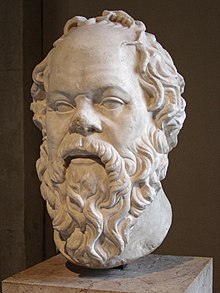Philebus
Socrates explores the causes, origins, and characteristics of various forms and mixtures of pleasure and pain that occur in human life and their changing combinations, which result in diverse emotional states.
[3][4][note 1] The hypothesis that Philebus was Plato's response to the hedonism of Eudoxus of Cnidus has led to the suggestion that the composition dates soon after 360 BC, though this attribution is highly uncertain.
[22] As a dialogue character, Protarchus, like Philebus, represents the Athenian upper class, in which educational efforts were valued and philosophical topics sparked interest during the time of Socrates.
[d] Dorothea Frede believes that Protarchus was one of the two sons of the wealthy Athenian known in the scholarly literature as "Callias III" who are mentioned in Plato's Apology.
Socrates has disputed this and argued for the counter-thesis that there are more important and advantageous things: reason, knowledge, and memory, a correct understanding, and truthful deliberation.
[i][31][32] The general problem that the conversationalists have encountered is the relationship between one and many, one of the core themes of Platonic philosophy, which questions how it is possible that pleasures or reason can both consist of different kinds but yet still form a unity that justifies the common concept.
One is only linguistically or musically competent if one knows the number and types of relevant sounds or tones, i.e., can fully and correctly classify the individual elements of the respective set.
Their cause – the fourth category – is what curbs the potentially unlimited with measure and order, ensures the right mixture ratios, and thus produces all that is beautiful and valuable.
Similarly, an unnatural excess of heat or cold causes pain, while returning to harmony through cooling or warming creates a pleasant feeling.
[u][note 2] Socrates now takes a new approach, starting from the observation that only relatively strong bodily changes are perceived and provoke pleasure and pain.
In the case of purely mental pleasures, this can be well observed in the theater, for example, in a tragedy, where the audience sheds tears and rejoices at the same time.
In comedy, too, the mixture becomes apparent: The audience laughs, thus feeling pleasure, but the enjoyment is based on envy, a negative emotion, which is a form of displeasure.
Again, the question of "purity" and "truth" arises, here relating to the accuracy and reliability of the results provided by various fields of knowledge – crafts and sciences.
When considering the utility of these fields from this perspective, the superiority of those disciplines involving calculation and measurement over the less precise ones, which rely on observation and estimation, becomes evident.
According to his interpretation, the primary concern is that Socrates acts as a therapist, a "soul doctor," who, like a physician, first makes a diagnosis and then turns to therapy.
This assumption fits the hypothesis that Plato distanced himself from the theory of forms in his last creative period, having abandoned it or at least considered it in need of revision.
However, Plato's Socrates in the Philebus places great emphasis on the distinction between the superior realm of unchanging being and the world of becoming and passing away dependent on it.
The view of the "Unitarians," who believe he consistently maintained a coherent perspective, is opposed to the "development hypothesis" of the "Revisionists," who assume a deviation from the theory of forms or at least from its "classical" variant.
[96] Donald Davidson took a “revisionist” stance on the Philebus: Plato, when he wrote this dialogue, no longer believed that the theory of forms could be the main foundation of an ethical concept.
The “More and Less” in the Philebus, the capability for increase and decrease, is accordingly “the Great and Small” or “the Great-Small” (to méga kai to mikrón) of the unwritten doctrines; with this concept, Plato is said to have described the indeterminate dyad.
For Plato's Socrates, proportion, or equal measure plays a central role both in the order of the world and in human life as the basis of all that is good and beautiful.
This emphasis on the mathematical order of the world and its philosophical exploration, as well as the opposition between limitation and boundlessness, reveals the influence of Pythagoreanism on Plato.
[107][108][109] Although Plato's student Aristotle never names Philebus explicitly, he engaged deeply with the Platonic theory of pleasure, and often refers to it in content.
[112] The rhetorician and literary critic Dionysius of Halicarnassus praised Philebus; he noted approvingly that Plato had preserved the Socratic style in this work.
[citation needed] The historian of philosophy Diogenes Laertius classified it among the “ethical” writings and gave the alternative title “On Pleasure”.
Porphyry’s student Iamblichus († around 320/325), a leading representative of late antique Neoplatonism, instructed his school to study Philebus as one of the twelve dialogues he considered most important.
Already in early 1464, Cosimo had expressed his special interest in Philebus, “Plato’s book on the highest good,” as he sought nothing more eagerly than the knowledge of the surest way to happiness.
Additionally, Ficino wrote a commentary on the dialogue, the third and final version of which was printed in 1496, and he delivered lectures to a large audience on the issues discussed in Philebus.
[note 6] Friedrich Wilhelm Joseph Schelling drew on Philebus in his 1794 essay Timaeus, where he dealt with the question of the emergence of a perceivable world.
He attempted to show with Philebus that the idea of the good, according to Plato’s view, is immanent in human life and an aspect of lived experience.



